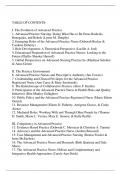TABLE OF CONTENTS:
I. The Evolution of Advanced Practice
1. Advanced Practice Nursing: Doing What Has to Be Done-Radicals,
Renegades, and Rebels (Lynne M. Dunphy)
2. Emerging Roles of the Advanced Practice Nurse (Deborah Becker &
Caroline Doherty)
3. Role Development: A Theoretical Perspective (Lucille A. Joel)
4. Educational Preparation of Advanced Practice Nurses: Looking to the
Future (Phyllis Shanley Hansell)
5. Global Perspectives on Advanced Nursing Practice by (Madrean Schober
& Anna Green)
II. The Practice Environment
6. Advanced Practice Nurses and Prescriptive Authority (Jan Towers)
7. Credentialing and Clinical Privileges for the Advanced Practice
Registered Nurse (Ann Carey & Mary Smolenski)
8. The Kaleidoscope of Collaborative Practice (Alice F. Kuehn)
9. Participation of the Advanced Practice Nurse in Health Plans and Quality
Initiatives (Rita Munley Gallagher)
10. Public Policy and the Advanced Practice Registered Nurse (Marie Eileen
Onieal)
11. Resource Management (Eileen D. Flaherty, Antigone Grasso, & Cindy
Aiena)
12. Mediated Roles: Working With and Through Other People by (Thomas
D. Smith, Maria L. Vezina, Mary E. Samost, & Kelly Reilly)
III. Competency in Advanced Practice
13. Evidence-Based Practice (Deborah C. Messecar & Christine A. Tanner)
14. Advocacy and the Advanced Practice Nurse (Andrea Brassard)
15. Case Management and Advanced Practice Nursing (Denise Fessler &
Irene McEachen)
16. The Advanced Practice Nurse and Research (Beth Quatrara and Dale
Shaw)
17. The Advanced Practice Nurse: Holism and Complementary and
Integrative Health Approaches (Carole Ann Drick)
,18. Basic Skills for Teaching and the Advanced Practice Nurse (Valerie
Sabol, Benjamin A. Smallheer, & Marilyn H. Oermann)
19. Culture as a Variable in Practice (Mary Masterson Germain)
20. Conflict Resolution in Advanced Practice Nursing (David M. Price &
Patricia Murphy)
21. Leadership for APNs: If Not Now, When? (Edna Cadmus)
22. Information Technology and the Advanced Practice Nurse by (Robert
Scoloveno)
23. Writing for Publication (Shirley Smoyak)
IV. Ethical, Legal and Business Acumen
24. Measuring Advanced Practice Nurse Performance: Outcome Indicators,
Models of Evaluation and the Issue of Value (Shirley Girouard, Patricia
DiFusco, and Joseph Jennas)
25. Advanced Practice Registered Nurses: Accomplishments, Trends, and
Future Development (Jane M. Flanagan, Allyssa Harris, & Dorothy A.
Jones)
26. Starting a Practice and Practice Management (Judith Barberio)
27. The Advanced Practice Nurse as Employee or Independent Contractor:
Legal and Contractual Considerations (Kathleen M. Gialanella)
28. The Law, The Courts, and the Advanced Practice Registered Nurse
(David M. Keepnews)
29. Malpractice and the Advanced Practice Nurse (Carolyn T. Torres)
30. Ethics and the Advanced Practice Nurse (Gladys L. Husted, James H.
Husted, & Carrie Scotto)
, Test Bank Advanced Practice Nursing : Essentials for Role
Development 5th Edition Joel Top Rated Examination Study
Guide Latest Version 2024
Chapter 1 . Advanced Practice Nursing: Doing What Has to Be Done-Radicals, Renegades, and
e e e e e e e e e e e e e
Rebels
e
MULTIPLE CHOICE e
1. The nurse manager of a pediatric clinic could confirm that the new nurse recognized the purpose
e e e e e e e e e e e e e e e
of the HEADSS Adolescent Risk Profile when the new nurse responds that it is used to assess for
e e e e e e e e e e e e e e e e e e
e needs related to
e e
a. anticipatoryguidance. e
b. low-risk adolescents. e
c. physical development. e
d. sexual development. e
ANS: A e
The HEADSS Adolescent Risk Profile is a psychosocial assessment screening tool which assesses
e e e e e e e e e e e e
home, education, activities, drugs, sex, and suicide for the purpose of identifying high-risk
e e e e e e e e e e e e e
e adolescents and the need for anticipatory guidance. It is used to identify high-risk, not low-risk,
e e e e e e e e e e e e e e
e adolescents. Physical development is assessed with anthropometric data. Sexual development is
e e e e e e e e e e
e assessed using physical examination.
e e e
REF: 6 OBJ: NCLEX Client Needs Category: Health Promotion and Maintenance
e e e e e e e e e e
2. The nurse preparing a teaching plan for a preschooler knows that, according to Piaget, the
e e e e e e e e e e e e e e
expected stage of development for a preschooler is
e e e e e e e e
a. concrete operational. e
b. formal operational. e
, c. preoperational.
d. sensorimotor.




